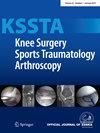A new preclinical sheep model of medial meniscus anterior root repair: Part 1—Quantitative morphology and relationships to adjacent structures
Abstract
Purpose
To analyse the quantitative morphology of the menisci, their roots and relations with a focus on the medial meniscus anterior root (MAR) as a basis for a preclinical model.
Methods
Data was obtained from 24 tibial plateaus of skeletally mature, female Merino ewes. The MAR attachment (MARA) was scanned with micro-computed tomography and stained with hematoxylin and eosin. Data of relevant anatomical structures was subjected to principal component analysis (PCA) and Spearman correlations.
Results
The osteo-ligamentous junction of the MARA represents a classical enthesis with a type-I insertion into the cortical bone. The medial tibial plateau was of a significantly smaller area than lateral. Its sagittal length was significantly longer than lateral. The widths of the MAR and lateral meniscus anterior root (LAR) were approximately half of both anterior horn widths. The MAR was significantly wider than the LAR. The medial meniscus body, posterior horn and medial posterior root were significantly thinner than lateral. PCA and cluster analysis revealed a striking, significant distinction between the structures of the medial and lateral tibial plateau. The sagittal length of the articular cartilage of both tibial plateaus correlated with the primary axis length of both menisci. The maximum width of the articular cartilage of both plateaus correlated with the area of both menisci. Significant correlations also existed between the length of the MAR and the total width of the tibia plateau and between the size of the MARA and the coronal distance to the medial tibial eminence (MTE), to the tibial tuberosity and the sagittal distance to the MTE.
Conclusion
The ovine MAR may be appropriate for repair approaches because of its morphological similarities to the human situation. The substantial differences between the medial and lateral tibial plateau have to be respected.
Level of Evidence
Not applicable.






 求助内容:
求助内容: 应助结果提醒方式:
应助结果提醒方式:


